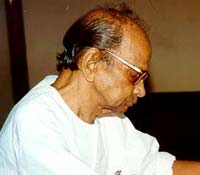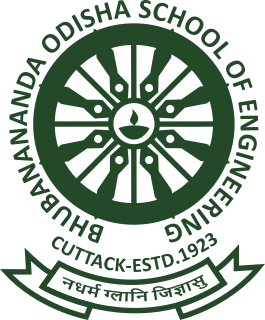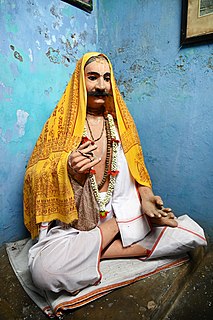History
Mother's work in Odisha began in 1949 when two research cycles were formed with the permission of Sri Aurobindo (one at Rairangpur in 1949 and another one at Cuttack in 1950). Sri Ramakrishna Das by the name of Babaji Maharaj, who was a Sanyasi at Ajodhya, He joined Sri Aurobindo Ashram on February 2, 1945, in Pondicherry. Babaji Maharaj tried to open the people of Orissa to the ceremony of Mother and Sri Aurobindo.
With Mother's happy blessing and Prapatti as an able instrument, the first period of work included the establishment of Study Circles, Students and Youth federations, Women's Study Circles, area, and state-level Study Circle Meets. In the next phase Education Centres, Relics Centres with experiments in combining living were inaugurated. Prapatti under the vital guidance of Babaji Maharaj had been organizing all these activities. When Prapatti died. Babaji Maharaj wanted all operational work of Orissa to be organized in Orissa, centrally from Matrubhaban, Cuttack.
The workers of Sri Aurobindo Study Circles throughout Orissa came stable at Matrubhaban to plan out the line of action as per the guidelines given by Babaji Maharaj. The final negotiation or advice on organizational matters
were however achieve by Babaji Maharaj.
A disparate circumstance grew after Babaji Maharaj died and almost 500 energetic workers from all parts of Orissa came together. on 20th Dec’1998 and settle to continue as before, Mother's Work in Orissa, according to the orders given by Babaji Maharaj and Prapatti. The following plans were decided by the members present. The committee is named as All Orissa Sri Aurobindo Study Circle Committee, having its organizational office at Matrubhaban, Cuttack.

Odisha, formerly Orissa, is an Indian state located in Eastern India. It is the 8th largest state by area, and the 11th largest by population. The state has the third largest population of Scheduled Tribes in India. It neighbours the states of West Bengal and Jharkhand to the north, Chhattisgarh to the west, and Andhra Pradesh to the south. Odisha has a coastline of 485 kilometres (301 mi) along the Bay of Bengal. The region is also known as Utkala and is mentioned in India's national anthem, "Jana Gana Mana". The language of Odisha is Odia, which is one of the Classical Languages of India.

Cuttack is the former capital and the second largest city in the Indian state of Odisha. It is the headquarters of the Cuttack district. The name of the city is an anglicised form of Kataka which literally means The Fort, a reference to the ancient Barabati Fort around which the city initially developed. Cuttack is known as the Millennium City as well as the Silver City due to its history of 1000 years and famous silver filigree works. It is considered as the judicial capital of Odisha as the Orissa High Court is located here. It is the commercial capital of Odisha which hosts many trading and business houses in and around the city. Cuttack is famous for its Durga puja which is the most important festival of Odisha. Cuttack is also the birthplace of Netaji Subhas Chandra Bose. The city is categorised as a Tier-II city as per the ranking system used by Government of India.

Cuttack district is one of the 30 districts of Odisha state in India. It is located in the coastal part of the state and its administrative headquarters are located in the city of Cuttack. As of 2011 Census, after Ganjam, it is the second most populous district of Odisha, with a population of 2,624,470. The name is an anglicized form of Kataka or Katak meaning Fort – referring to the Barabati Fort. The district is bisected by the river Mahanadi and its numerous distributaries and occupies a large portion of the river's delta. It is bounded by the Angul, Dhenkanal, Nayagarh and Khurda districts to the west while its southern and eastern boundaries touch Puri, Jagatsinghpur, Kendrapara and Jajpur districts.

Rairangpur is a city and a tehsil of Mayurbhanj district in the state of Odisha, India. It is based at about 287 Kilometres from the state capital Bhubaneswar and 82 kilometres from the district headquarters of Baripada and about 73 kilometres from Jamshedpur. The Kharkhai (Suleipat) Dam and the Simlipal Tiger Reserve are the nearby local attraction at the approachable distance, attracting many foreign tourists here.This is a notable mining area of Odisha, comprises iron-ores from Gorumahisani, Badampahar, Suleipat mines.It is Mayurbhanj's second largest city after Baripada.

Bissam Cuttack is a census town in the Rayagada district, within the state of Odisha, India. It is one of the identified Tourist Centres of Odisha.

Manoj Das is an Indian author who writes in Odia and English. In 2000, Manoj Das was awarded with Saraswati Samman. He was awarded Padma Shri in 2001, the fourth-highest Civilian Award in India, Padma Bhusan in 2020, the third highest Civilian Award in India for his contribution in the field of Literature & Education.

Amarendranath Chatterjee was an Indian independence movement activist. In charge of raising funds for the Jugantar movement, his activities largely covered revolutionary centres in Bihar, Odisha and the United Provinces.

Previously a neglected aspect of the Indian Central government, Education in Odisha is witnessing a rapid transformation. Its capital city, Bhubaneswar, is emerging as a knowledge hub in India with several new public and private universities, including the establishment of an Indian Institute of Technology after five decades of demand.

Ravenshaw University is a co-educational state university situated in Cuttack, Odisha on the eastern coast of India. Founded as Ravenshaw College in 1868, the institution became a university in 2006. The university has nine schools, thirty three academic departments and a student enrolment of nearly 8,000. It is one of the oldest educational institutes in the country and its history is synonymous with the history of modern Odisha.
Odia Muslims are a community of people hailing from the Indian state of Odisha who follow Islam and primarily speak Odia language. They mostly descend from indigenous converts to Islam along with a small proportion that migrated from northern India. They are marked by their distinctive religious practices, food habits and language.

Indian Institute of Technology Bhubaneswar is a public technical and research university established by the government of India in 2008, located at Bhubaneswar, Odisha, India. It is one of the eight new Indian Institutes of Technology (IITs) established by the Ministry of Human Resource Development, Government of India under The Institutes of Technology (Amendment) Act, 2011 which establishes the eight new IITs as well as declares IT-BHU as Indian Institute of Technology. The Act was passed in the Lok Sabha on 24 March 2011 and by the Rajya Sabha on 30 April 2012. It started functioning from the campus of IIT Kharagpur on 23 July 2008 and shifted its operation to the city of Bhubaneswar on 22 July 2009.

Mrinal Chatterjee is a media educator, author and trainer from Odisha, India and works as a professor and center head in the Indian Institute of Mass Communication, Dhenkanal. He is the author of the book History of Journalism in Odisha, which is the first major publication on the history of journalism in Odisha. The book explains the state of journalism in Odisha from its beginning in the mid 19th century till mid-2013.

Krushna Chandra Gajapati, honorably known as Maharaja Sir Krushna Chandra Gajapati Narayana Dev KCIE, was a key personality and regarded as the architect of an Independent united Odisha State. Sir Gajapati was a scion of the great Eastern Ganga Dynasty of Paralakhemundi, a Great Freedom Fighter, the first Prime Minister of Odisha and one of the founding fathers of the Indian Constitution, being a Member of the Constituent Assembly of India. The present-day Gajapati District of Odisha which was earlier a part of the historic Ganjam district was named after him.

Gopal Chhotray (1916–2003) was born in Puranagarh village of Jagatsinghpur district in Odisha, India.

Bhubanananda Odisha School of Engineering (BOSE) -aka- ଭୁବନାନନ୍ଦ ଓଡିଶା ଯାନ୍ତ୍ରିକ ବିଦ୍ୟାଳୟ, କଟକ, is the oldest diploma engineering school in Odisha located in Cuttack, Odisha, India.
Sailabala Das was a social worker and politician. She was the first woman from Odisha to go to England for higher studies.

Sarojini Hembram is an Indian politician from the Odisha state. She belongs to the Biju Janata Dal (BJD) party. She was elected to the Odisha Legislative Assembly from Bangriposi in 2009 and became the minister for textile, handlooms and handicrafts in the Odisha Government. She was elected to the Rajya Sabha the Upper house of Indian Parliament in 2014 from Odisha.

Kuntala Kumari Sabat (1901–1938) was an Odia poet during colonial India. She was one of the women poets who came into prominence from Odisha during India's freedom struggle. She was multifaceted personality. She was a physician, writer, poet, editor, leader of nationalist movement and social worker. She was honored with Utkala Bharati in 1925.

Gopalakrusna Pattanayaka (1784-1862) was an Odia poet & composer of Odissi music. His songs, including chaupadis, chautisas, koilis, pois are central to the popular repertoire of Odissi music and are widely sung in Odissi music recitals across the state, as well as other allied traditional artforms of Odisha, such as pala. The 20th-century Odissi musician, vocalist & binākara Apanna Panigrahi, also from the poet's hometown, was well-known for his renditions of Gopalakrusna's lyrics. Some of the most iconic Odissi songs, such as Syamaku Juhara Tara Premaku Juhara Ma, Jala Ani Jai Kali Kalindasutaku, Sangini Re Rasarangini Re, Kadamba Bane Bansi Bajila Re, Uthilu Ede Begi Kahinkire, Ki Nadare Prana Sangini, Manasija Mana Mohana are creations of Gopalakrusna. Many of his creations are also popular as abhinaya items in Odissi dance.













